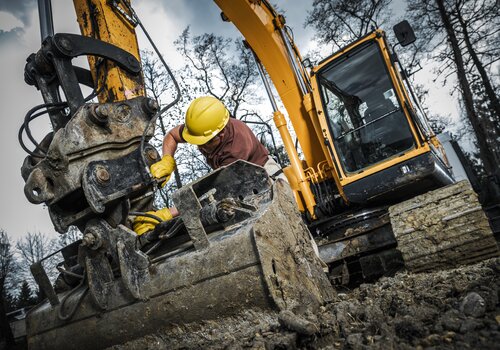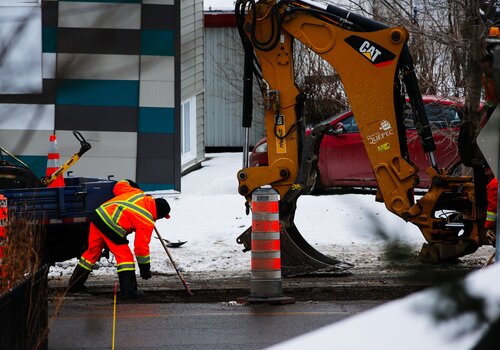Ice, snow and freezing temperatures can add risk to all aspects of construction projects. Keep your people, your equipment, your site and your bottom line safe in the cold season with some simple strategies.
Make sure your equipment is winter-ready
Whether your equipment needs to face the elements or be stored away for the season, start with a thorough inspection of each piece. Hoses, belts, fittings and other hardware are particularly susceptible to wear and tear, so make sure to repair or replace any components showing damage. Install winter tires or tracks, if needed, to get through heavy snow. Replace or replenish fluids and be aware of the impacts of freezing temperatures; topping up gas tanks reduces condensation and provides peace of mind during bad weather delays.
If storing equipment, make sure it’s clean and the oil changed before stowing in a dry and unheated location. Disconnect batteries or use a trickle charger to charge to a low level.
Make sure your site is winter-ready
Cold weather can cause significant dangers on construction sites. Uneven surfaces may be hidden under snow, concealing trip hazards; even smooth surfaces become dangerous when slicked with ice. Fluctuating temperatures cause wet, muddy conditions that quickly become dangerous to people and perilous to equipment. Consider how the changing weather may affect the site and what, if anything, can be done about it. Be prepared to adjust your work plan and your workplace as conditions change. Invest in the tools needed to keep the site free of ice and snow: shovels, brooms, brushes and ice melter should all be on hand. Assign people to be responsible for ongoing snow removal; make it their job to keep the winter work site clear and safe.
Make sure your team is winter-ready
Protect your most valuable resource (the human one) by providing clear instruction about appropriate winter dress. Layering clothing provides comfort on colder- or warmer-than-expected days and in shifting temperatures; having an extra change of clothes on hand protects against chill or discomfort in wet conditions. Extremities need more protection: layer socks and even gloves or mitts to fend off frostbite. But be cautious with cold weather wear in the presence of heavy equipment – long scarves create more danger than comfort so insist on close-fitting garments.
Educate your people about the signs of cold stress and how to prevent them, especially newer workers who may be unfamiliar with outdoor work. Provide a warm dry shelter for warming during intense weather and encourage workers to take regular breaks to warm up, change out of wet clothing and drink some warm liquids.
Conditions can change quickly and dramatically in the winter months. Be prepared to change course just as quickly by having a solid emergency response plan. In bad weather, emergency services may be slower to respond to calls; ensure that first aid supplies are readily available and that people have been trained with the basic skills to use them in an emergency. Keep a stock of blankets, batteries, flashlights, radios and snow removal equipment in an easily accessible and protected space. Prior to the season, draft an emergency evacuation plan and familiarize the team with it. Keep a current list of contact information so you can text or call people to check that they got home safely.
Make sure your budget is winter-ready
Working through the winter can increase your labor, material and fuel costs, so review your options carefully ahead of the season. Difficulty digging in frozen ground, additional additives and equipment to facilitate concrete and masonry work, and productivity lost to weather shutdowns can pile costs up quickly. Generally, the lower the temperature, the higher the potential costs. Consider early on if the winter work is truly necessary or if costs can be contained by starting the job earlier or later in the season. Careful planning can minimize the budget creep caused by cold weather conditions.
Photo credit: VADZIMMASHKOU/BIGSTOCKPHOTO.COM












